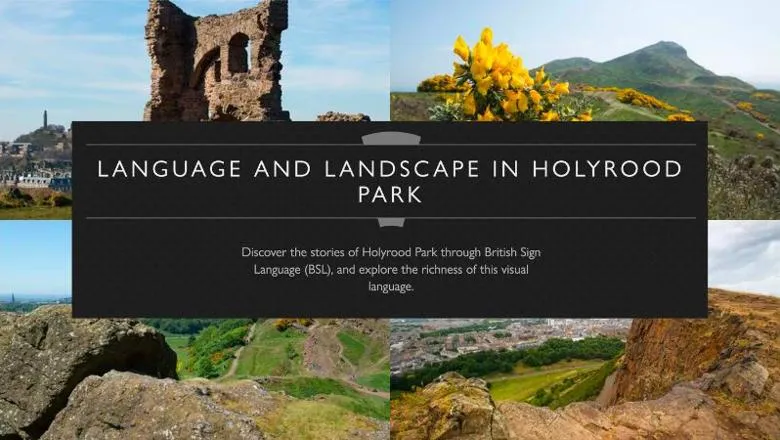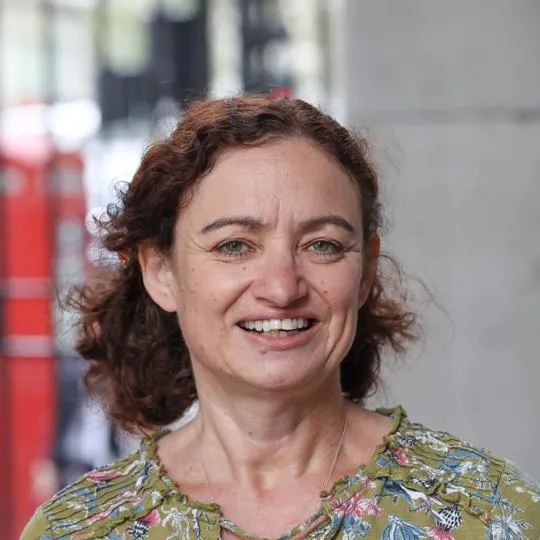While learning BSL (as a congenital oral deaf person), I started going to the numerous Deaf-led BSL tours run in museums. I then started wondering how this visual-spatial language enabled us to engage with visual-material culture differently and even better than linear spoken language. This collaboration with HES offered the opportunity to explore BSL stories and investigate how the syntax and grammar was working in a cultural space.
Dr Ellen Adams, Reader in Classical Archaeology and Liberal Arts
04 January 2023
King's project to promote the use of British Sign Language
Dr Ellen Adams has partnered with Historic Environment Scotland (HES) to showcase four stories about Holyrood Park and to explore how public bodies can encourage the use of British Sign Language (BSL).

The Language and Landscape project, led by King’s Dr Ellen Adams in collaboration with HES and supported by Deaf performer Trudi Collier and Heriot-Watt University linguist Dr Robert Adam, provides a tour of Holyrood Park in Edinburgh using BSL. Developed in response to Scotland’s 2015 BSL Act, the project aims to investigate how public bodies, like HES, can promote the use of BSL through the presentation and analysis of stories performed in BSL.
Holyrood Park is explored through four stories that are presented in BSL with captions and voiceover in English to also provide accessibility for non-BSL users. Topics range from the park’s historical sites, such as St Anthony’s Chapel, to the legend of how the park was given its name. These stories can be accessed via QR codes set in the park or via HES’s website.
The above YouTube video is one of the four stories included in the tour of Holyrood Park. This video is the story of St Anthony's Chapel at Holyrood Park.
Alongside its aim to enrich visits to the park, the project highlights what BSL as a visual language can bring to our understanding of landscape. Following the stories are language notes, which are videos featuring Ellen Adams and Robert Adam where the pair discuss how BSL language techniques were used during the storytelling. These linguistic notes are provided to help hearing people and BSL users and learners understand how this visual-spatial grammar can be a powerful mode of communication when exploring art, archaeology and landscape.
The above YouTube video is one of the language notes included in the tour of Holyrood Park. This video explains how placement is used to add detail into BSL signs during the story of St Anthony's Chapel.
I really loved the linguistic interviews. They drew out features of BSL that I'd often wondered about but didn't know how to explore. It made me think differently about how we narrate a historical story, or how we dramatise the history of a specific place if we can't use spoken words.
People who have experienced the tour of Holyrood Park
Sally Gall, Interpretation Officer (Access and Audiences) at Historic Environment Scotland:
"At HES, it’s our aim to ‘share and celebrate’ the Historic Environment, and to ensure that heritage makes ‘a real difference to people’s lives’. We manage many historic sites, including Edinburgh’s Holyrood Park – a landscape rich with scientific, environmental and geological significance, as well as having many tales to tell of human history, folk lore and legend.
We are always working to ensure that our sites reflect diverse histories and approaches to telling them. In this project, we were keen not only to provide access to the park’s stories for BSL users, but – as the BSL Scotland Act 2015 says – to ‘promote’ BSL, to celebrate what such a visual and vibrant language can bring to our understanding of concepts and stories, for both BSL users and hearing visitors alike."
In this project, we were keen not only to provide access to the park’s stories for BSL users, but – as the BSL Scotland Act 2015 says – to ‘promote’ BSL, to celebrate what such a visual and vibrant language can bring to our understanding of concepts and stories, for both BSL users and hearing visitors alike.
Sally Gall, Interpretation Officer (Access and Audiences) at Historic Environment Scotland
Before the Language and Landscape project, Dr Ellen Adams established the Museum Access Network for Sensory Impairments (London) to investigate how humanities scholars can engage with disability studies. Dr Adams is currently working with the British Museum and the Ashmolean Museum with plans to promote BSL in these institutions when exploring landscape, monuments and objects.

